Frequently asked questions
FAQ
Here we've tried to answer some of the most common questions about our canopies and shelters.
Questions have been divided into sections to make them easier to find.
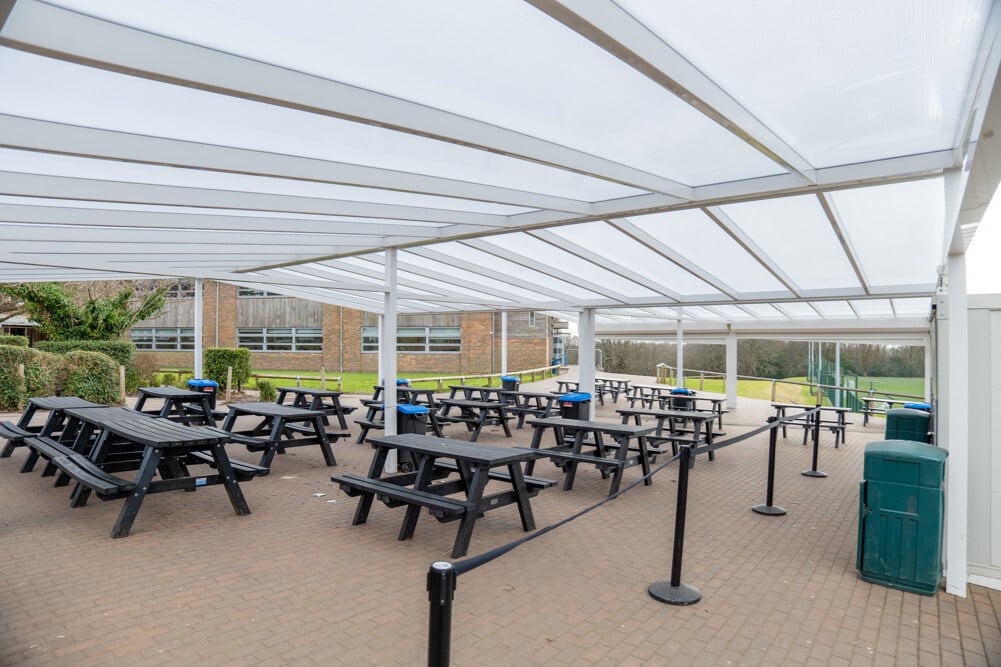
General FAQs about Canopies for Schools
Our canopies are very popular with schools looking for versatile, high quality covered space that delivers lasting value. Find our education-specific FAQs here.
What is a school canopy?
A school canopy is an outdoor shelter which is frequently used in schools to create extra covered space. Canopies can be used for outdoor learning and play, as walkways or to create extra dining space.
School canopies come in many different materials and designs, including aluminium canopies, timber canopies and tensile fabric canopies and sails. They can also be adapted to your needs by installing side walls, retractable blinds, lighting, heating, solar panels and more.
Installing solar panels on the roof is a recent and increasingly popular innovation, allowing schools to cut their energy bills while also reducing their carbon footprints.
Find out more about our canopies for schools here.
What are the benefits of canopies for schools?
Installing a canopy or shelter at a school has numerous benefits. These include:
- Increased covered space for year round outdoor learning and play
- Cost-effective alternative to a building extension
- Enables schools to increase dining capacity fast
- Encourages increased outdoor learning and socialising among students, which is proved to improve mental health, social skills and academic attainment.
- (If solar panels are installed) Generates renewable energy which cuts energy costs and reduces carbon footprint
Can you have a solid roof on a canopy, to provide protection from the sun?
Yes, it is possible to choose a solid roof (which doesn't allow light through) for your canopy. We offer a range of options, including aluminium panels or the option to install solar panels. Our most popular roofing choice is opal polycarbonate, which has a milky appearance; it allows light through but prevents glare.
However, the polycarbonate we use has a double UV-protective coating, which blocks 98% of all harmful UVA and UVB rays (the most dangerous types).
Please get in touch if you'd like more information.
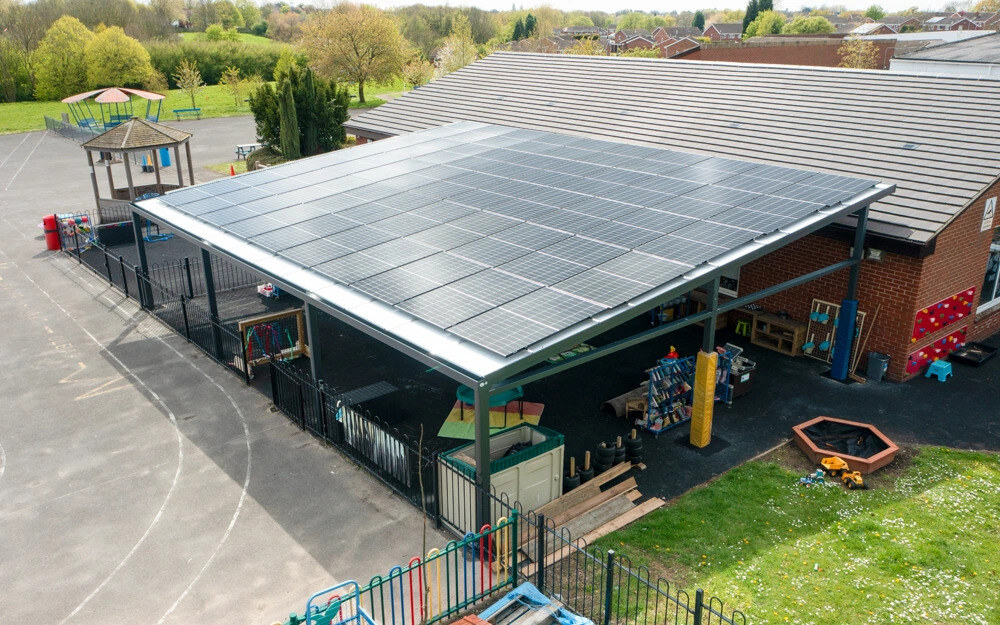
Can you add solar panels to a canopy?
Absolutely yes, as our case studies Three Peaks Academy and Cleeve School prove.
Our Spaceshade, SpaceMax and MUGA-shade canopies are designed to accommodate the significant weight of solar panels, unlike other alternatives on the market.
Solar panels can be installed on a canopy roof during the initial installation or retrofitted later.
They not only significantly reduce energy costs but contribute towards Net Zero and sustainability goals.
Find out more about our solar panel canopies.
What is the best way to clean my canopy?
Water, mild detergent and a long-reach soft bristle brush are ideal for removing dirt without damaging the structure.
Make sure you clear the roof and gutter of debris to avoid any long-term damage or blocked downpipes.
Use care when accessing the roof, using either crawler boards or another type of safe access to ensure safety.
Regular cleaning helps to avoid damage and keeps the canopy looking good for many years.
Kensington Systems offers professional cleaning services for those who are unable or don't have time to clean themselves.
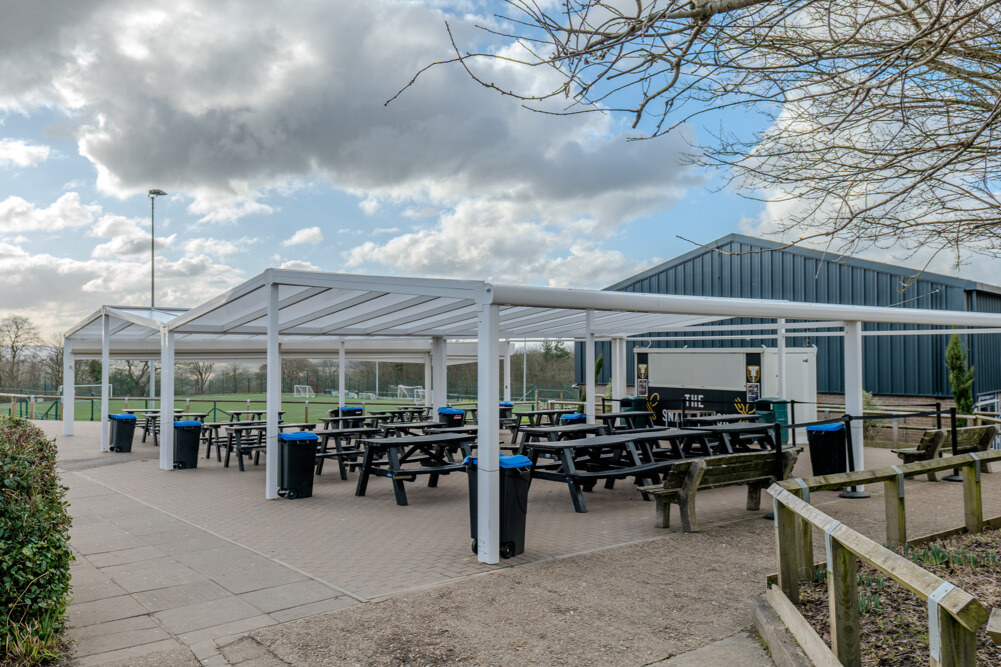
School canopy prices; how much does a school canopy cost?
The cost of your playground canopy will depend on a number of factors, including overall size, extent of groundworks, and choice of extras like side walls.
As a general rule, you can expect to pay anything between £300-£800 (ex VAT) per sqm for a fully installed canopy (including groundworks), depending on the size and circumstances.
The cost per sqm reduces significantly as the canopy increases in size.
What accreditations do you hold?
We are proud to hold a number of well-known and respected accreditations, including ISO:9001 Quality Management and SMAS health and safety accreditation.
We are also accredited by Planet Mark, showing our commitment to reducing our carbon footprint in line with UN Sustainable Development Goals, and are proud to have achieved a reduction of over 7 tonnes of carbon emissions in our first year.
Contact us for further information.
You say your canopies have a 25 year life expectancy. Will the canopy last for more than 25 years?
Our canopies are manufactured from hardwearing aluminium and steel. While we cite 25 years as its expected lifespan, with regular maintenance and upkeep it should last much longer.
Keeping the canopy clean and clear of debris will also help it to last longer.
.jpg)
FAQs about Canopy Installation
Find the answers to your questions about canopy and shelter installation here.

What foundations are required for a canopy installation?
Canopy installations require concrete foundations, which are usually either concrete pads (individual square foundations) or strip foundations (a shallow trench filled with concrete).
The type of foundation we use depends on the canopy design and site conditions.
For example, if services like water pipes or electricity are located near the surface, we may have to make foundations wider and less deep to compensate.
We work with structural engineers to ensure our foundation design for each project is correct and compliant with regulations.
What about drainage?
Our clients can choose between two different types of drainage for Spaceshade canopies:
- Surface drainage - where water is discharged directly to the playground surface and drains into existing channels
- Underground drainage - where the drainage channels in the posts are connected directly to new or existing underground drainage channels. This option prevents any build-up of surface water in the playground, but may cost more if additional groundworks are needed.
Can you do groundworks along with the canopy?
Yes, absolutely. We do this for the majority of clients.
Can you do surfacing with the canopy and groundworks?
Yes, we can do surfacing alongside the canopy and groundworks.
This can range from simple playground repair to the installation of artificial grass, rubber crumb, or tarmac underneath the canopy as part of the canopy project.
Do you have enhanced DBS certification for working in schools?
Yes, our installers and supervisors hold enhanced DBS accreditation to enable them to work in schools.
Where in the UK do you install your canopies?
We are based in Bristol, but install our canopies and shelters in schools, business, sports centres and healthcare facilities across the whole of the UK (including Scotland and Northern Ireland). We have also completed installations on the Isle of Man and Isle of Wight.
How long does a canopy take to install?
How long a canopy takes to install really depends on its size and what groundworks are required.
- A small canopy (approx 30-50 square metres could be installed within a day
- A very large or complex canopy with add-on features like solar panels or side walls could take 2-5 weeks
- Another 1-2 weeks should be added to the installation time if groundworks are included. This includes the time required for concrete foundations to harden sufficiently for the canopy to be installed on top.
Many schools choose to have their canopies installed during the school holidays, however it can just as easily be done during term time.We securely fence off the work area to prevent children or others accessing the site, and are experienced working within the restrictions of an operational school environment.
Do I need planning permission to install a school canopy?
Your canopy may fall under permitted development guidelines if it is
- More than 5 metres from the site boundary
- Lower than the height of the original building
- Less than 100 square metres or 25% of the original building's footprint (whichever is larger)
However, if it does not meet all of these requirements or the school is listed or in a conservation area, you will likely need to apply for planning permission.
We can help you through the process, including by providing detailed drawings and visuals.
Find out more about planning permission for canopies here.
Do I need planning permission to install a walkway canopy?
Your walkway canopy may fall under permitted development guidelines if it is -
- More than 5 metres from the site boundary
- Lower than the height of the original building
- Less than 100 square metres or 25% of the original building's footprint (whichever is larger)
However, if the walkway doesn't meet these conditions, or the building is listed or in a conservation area, you will likely need to apply for planning permission.
We can help you through the process, including by providing detailed drawings and visuals.
Find out more about planning permission for covered walkways here.
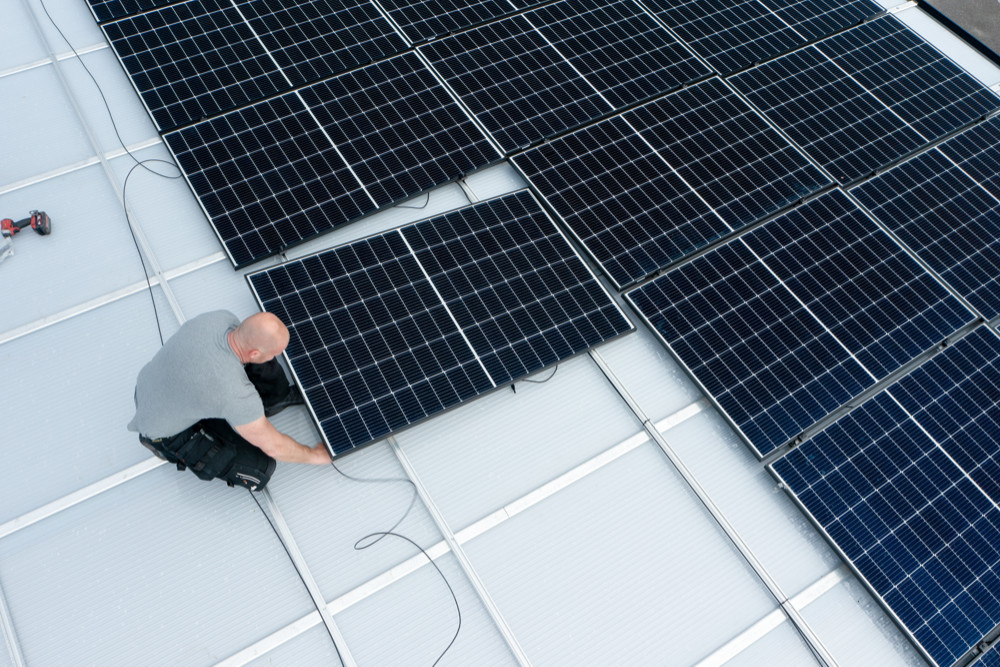
FAQs about Design & Structural
Find your answers to design and structural questions here.
What's the difference between Kensington Systems' Spaceshade canopy and alternatives that look the same?
Our Spaceshade canopy system is designed to deliver safety, high quality and long-term value.
Our system is solid and intended for heavy use (and abuse) in commercial, educational and healthcare settings.
Our canopies carry a certified non-fragile roof certification (to ACR[M] 001:2014) and are designed to accommodate solar panels, as well as larger gutters and cross members.
There are alternative products available that look very similar, but these are primarily intended for domestic use, with smaller gutters and structural members and lower quality fixings and rain seal. The domestic alternatives do not carry any safety certifications or carry the same life expectancy and build quality as a Spaceshade design.
Are your Spaceshade canopies structurally tested?
Yes, we work with structural engineers and manufacturing partners to ensure our canopies are structurally tested to be as safe as possible. This includes foundation design, wind and snow loadings and cross bracing for maximum rigidity.
Do your canopies comply with planning and building control?
Yes. With every design (especially large enclosed canopies) we ensure it is comfortable to use and legally compliant with planning and building control requirements, including ventilation, heating, fire protection etc
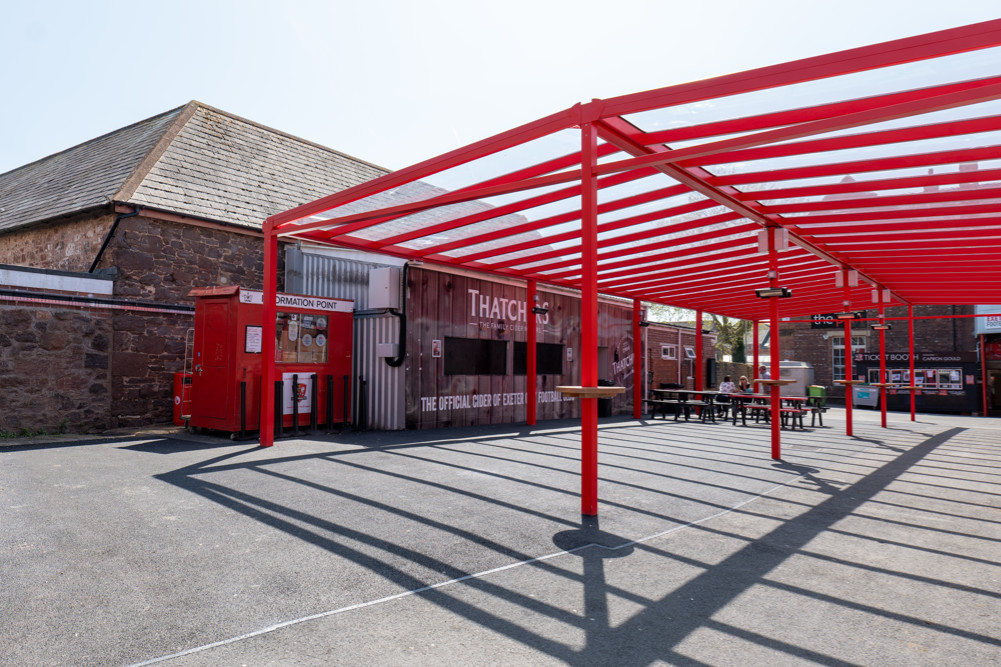
.jpg)
Why do you install cross-bracing on your canopies?
We install cross-bracing on our canopies to give them extra rigidity and strength, particularly when they support heavy loads such as solar panels or glazed roofs.
Will there be a deflection on the rafters if I get a large projection?
Deflection on a roof rafter refers to the amount a rafter bends or sags under load, such as the weight of roofing materials, snow, or people walking on the roof.
The degree of deflection depends to a large extent on the size and strength of the roof rafter. The larger & stronger it is, the less deflection there is. Some domestic-grade rafters are manufactured in smaller sizes to reduce costs; these can sag and deflect if the roof projection is too large
Using a Spaceshade canopy with correctly sized rafters should avoid this problem.
Is the gutter size of a canopy actually important?
Yes and no. For a smaller roof, the volume water running off it is small enough that a smaller gutter will be able to manage this.
However, for a larger roof (like a dining canopy) the volume of water draining is much larger, and ensuring the gutter is correctly sized is very important to avoid overflow or leaks.
Domestic grade canopies have small gutters typically designed for veranda and patio canopies; commercial grade canopies like Spaceshade have large ones designed for large roofs.
Enclosed canopies
A section heading with width, center align and XL size title options.
What's the best way to heat an enclosed canopy?
We generally recommend installing infra red heaters in an enclosed canopy and often do this alongside the canopy installation.
These are very effective at heating people (not just the surrounding air) and often only need to be switched on for a couple of minutes to reach a comfortable temperature inside. This helps keep costs down as well.
What's the best way to cool an enclosed canopy?
It's very important to ensure an enclosed canopy is correctly ventilated in accordance with building regulations. If it's done properly, maintaining airflow with this and open doors should help to keep the temperature down.
You can also explore installing solar panels or solid roof panels to help block the sun.
Does an enclosed canopy need heating and cooling?
An enclosed canopy would benefit from heating to make it more comfortable for winter use.
If the canopy has correct airflow and ventilation then cooling should not be required.
Can a walkway canopy be enclosed?
Yes, a walkway canopy can easily be enclosed. This is a popular option in healthcare settings, to provide protection and privacy for patients being moved around the hospital.
Polycarbonate or glass panels are the most popular methods for enclosing a walkway canopy.
